The Federal Reserve’s decision to cut interest rates by a quarter point has ignited debates about its true purpose and effectiveness. From a centrist perspective leaning slightly to the right, this move seems less like a bold solution and more like a calculated response to an economy that remains heavily tethered to government intervention. The central bank’s rationale may appear sound—aiming to ease borrowing costs and stimulate growth—but it raises questions about long-term consequences. Is this rate cut a genuine attempt to invigorate the market, or is it merely a political cover for the Fed to appear proactive while stirring the pot for broader economic risks?
This marginal reduction might seem beneficial on the surface, but it neglects the broader context: a sluggish economy still grappling with inflationary pressures. Far from signaling a return to healthy growth, this move suggests the Fed is simply delaying the inevitable correction, risking a cycle of reckless borrowing and overleveraging. It’s important for centrists to scrutinize whether this policy undermines fiscal discipline, or whether it aligns with a pragmatic approach of gradual adjustment, balancing inflation control with growth stimulation.
Consumers Will Feel the Short-Term Relief—But Is It Enough?
Much of the narrative centers around how everyday Americans will be affected. Credit cards, auto loans, mortgages—these are the arenas where most consumers will notice change. With variable-rate credit products tied directly to the Fed, borrowers can expect modest relief, perhaps a reduction of half a percentage point in interest costs by early 2026. Yet, the current landscape remains grim; credit card APRs teeter above 20%, and mortgage rates are still considerably higher than pre-pandemic levels.
This discrepancy between short-term optimism and long-term reality exposes a fundamental flaw: rate cuts do little to address underlying inflation. While some borrowers benefit temporarily, many are still stranded with high debt servicing costs, swallowing the inflated prices of goods and services. The broad consumer experience suggests that the Fed’s move is more of a superficial patch than a comprehensive solution. For the typical middle-income family, this rate cut might mean marginal savings on borrowing, but it won’t fix the persistent inflation that continues to erode purchasing power.
Mortgage and Auto Loan Dynamics: Limited Impact but Lingering Challenges
The fresh rate cut is unlikely to revolutionize the mortgage market. Most homeowners hold fixed-rate loans that aren’t directly affected, leaving many in a holding pattern. As mortgage rates have already declined from their peak earlier this year, additional cuts will have minimal immediate impact unless consumers choose to refinance or sell. This underscores a fundamental flaw: the majority of homeowners are locked into previous interest rates, and their financial stability depends largely on their existing mortgages’ fixed terms.
On the auto financing front, the situation is marginally more optimistic. Lower borrowing costs may bolster consumer confidence, encouraging car purchases despite high vehicle prices. But with the current average on a five-year loan around 7%, a modest rate cut isn’t enough to significantly lower monthly payments. Instead, it fuels a psychological boost—what some might dismiss as superficial—that could temporarily ignite automotive sales during promotional events. Such short-lived trends underscore the problem: monetary policy alone cannot solve structural issues like inflated prices and supply chain disruptions.
Student Loans and the Reality of Federal and Private Borrowing
Addressing student debt, the recent rate cut offers a mixed bag. Federal student loans, with their fixed interest rates reset annually, are largely unaffected directly. Yet, private student loans, often tied to benchmarks like the Treasury bill, could benefit from lower variable rates. For borrowers with these private loans, an impending rate reduction may ease their financial burden, potentially enabling some to refinance at lower costs.
However, the broader picture remains troubling. Federal student loan benefits—like income-driven repayment and deferments—are potentially slipping into irrelevance if borrowers shift to private loans for better rates. Such a shift could undermine borrower protections and deepen dependence on less favorable financing options. From a centrist-liberal perspective, this highlights how the overall system favors lenders over borrowers, undermining the long-term financial security and social mobility of the middle class.
Savers and the Yield Dilemma
One of the most negative aspects of the Fed’s rate cut is its impact on savers. While borrowers may find relief, those who rely on interest income suffer. The yields on high-interest savings accounts and certificates of deposit are already declining, and further cuts threaten to push these rates even lower. This imbalance exacerbates wealth disparities, punishing the prudent saver while encouraging risky borrowing behaviors.
For those who have diligently saved, the outlook is bleak. Locking in high-yield accounts now might seem advantageous, but the trend of declining yields suggests that future returns will be diminished. This only widens the gap between savers and borrowers, which is problematic from a centrist standpoint that advocates for balanced economic growth and prudent fiscal management. It becomes evident that aggressive rate cuts rarely benefit the broader middle class in the long run but do serve financial institutions’ interests.
The Broader Implications: A Cautionary Tale for Responsible Policymaking
Ultimately, the Fed’s rate cut exemplifies the peril of relying on monetary policy as a quick fix for deeply rooted economic issues. While it offers fleeting relief to certain segments of the population, it also risks fuelling inflationary pressures and financial instability down the line. From a pragmatic, center-right perspective, this emphasizes the need for a more disciplined approach—one that pairs sensible monetary policies with fiscal responsibility and structural reforms.
The danger lies in viewing rate cuts as a panacea, ignoring how they deepen inequality, distort markets, and postpone necessary structural adjustments. It’s undeniable that prudent policies should prioritize sustainable growth, fiscal discipline, and the protection of middle-class interests—rather than painting temporary victories with a broad brush of monetary easing. Only a balanced approach, wary of short-term gains and mindful of long-term stability, can truly sustain a resilient economy.

